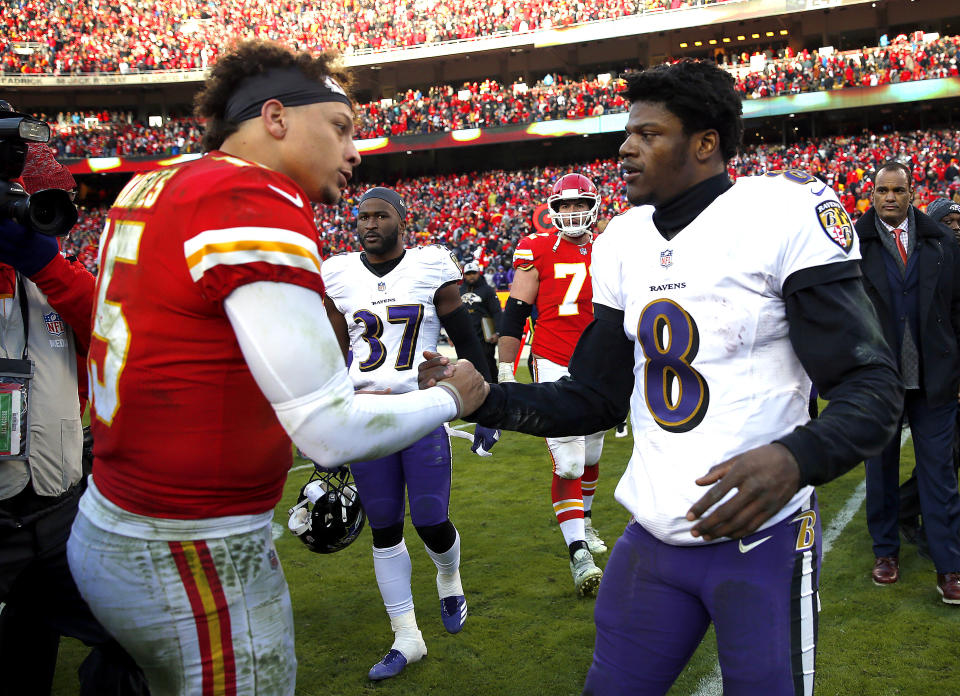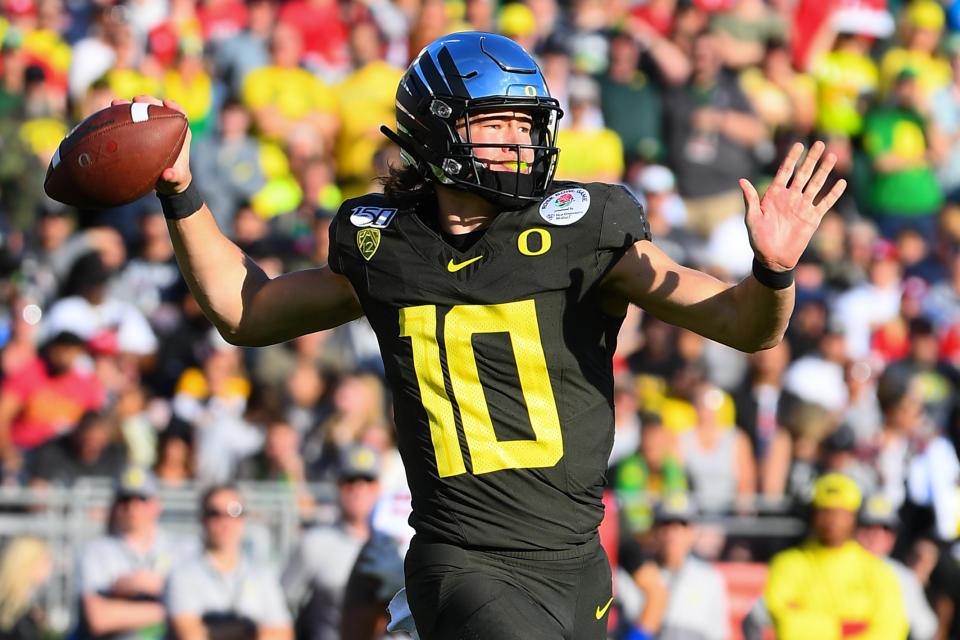Lamar Jackson and the Super Bowl QBs have changed how the NFL evaluates its most critical position
MOBILE, Ala. – The NFL’s presumptive MVP, Lamar Jackson, broke the league rushing record for a quarterback, becoming the first to finish among the league’s top 25 regular-season rushers since Randall Cunningham in 1990.
The two Super Bowl quarterbacks come from offenses that traditionally draw sour milk scowls from NFL front offices. Kansas City’s Patrick Mahomes played in an Air Raid style system at Texas Tech, while Jimmy Garoppolo played at Eastern Illinois in Dino Babers’ Baylor-inspired up-tempo spread system.
With NFL evaluators pouring into Mobile, Alabama, this week in preparation for the Senior Bowl, they arrive at a time when the traditional quarterback evaluation paradigm is amid an overhaul. Within the past five years, the traditional notions of “pro-style” systems and “dropback quarterbacks” that NFL decision-makers have clung to for decades have become antiquated.
The offensive revolution in college football the past two decades has been more of an incremental evolution in the NFL. Just five years ago, scouting groupthink led to beefy Blake Bortles being pick No. 3 and Garoppolo getting selected 59 picks later. In 2012, 6-foot-7 Brock Osweiler went 18 picks ahead of Russell Wilson.
So with Jackson finishing eighth in the NFL in regular-season rushing average (80.4 per game), Mahomes converting Andy Reid from a West Coast disciple to an RPO guru, and Garoppolo showing that spread-tempo quarterbacks can adjust to the NFL, is it time to rip up the traditional quarterback evaluation notions?
“If this season caused us to re-think it, we’re already too late,” said a veteran NFL scout. “I’m not being flippant. [Lamar] was awesome and that’s what you hope it looks like. But these are the quarterbacks that colleges give us now. We don’t get 6-foot-4, 235-pound pocket guys anymore and when we do we probably overrate them.

“We have 6-foot-1 to 6-foot-2, 205-pound runners who can sling it and make plays and come from offenses in high school and college that run the same offense. If we expect to have any success, we have to start tailoring what we do to that.”
It sounds simple. But the adjustment for the NFL to embrace schematic diversity and quarterbacks outside the dropback pocket passer paradigm has been a struggle. Arizona Wildcats coach Kevin Sumlin points to Wilson as a tipping point for the NFL evaluation of college quarterbacks. Wilson, who played his final season at Wisconsin, slipped to the third round in 2012 and has won a Super Bowl and been a seven-time Pro Bowler.
Sumlin said in a phone interview with Yahoo Sports on Monday that this season will be remembered as the one that unites the two disparate quarterback labels that players receive in high school. On recruiting sites like Rivals.com, quarterbacks are grouped as either pro-style or dual threat. Sumlin jokes that dual-threat means “not really a quarterback,” but those labels now appear to be melding together before our eyes.
“This group of quarterbacks in the NFL and in the playoffs have shown that they’re both,” Sumlin said. “Just this year’s playoffs alone have changed the thought process of what a dual-threat quarterback is.”
The extent of how much NFL evaluators evolve will be interesting. Oregon’s Justin Herbert is a 6-foot-6, 238-pound prospect who strikes the mold of the classic NFL quarterback archetype. (Think Ben Roethlisberger size.) He’s in Mobile this week along with former Oklahoma and Alabama quarterback Jalen Hurts, who authored one of the most prolific careers in recent college football history because of his ability to puncture defenses with both his arms and his legs.
Herbert is a lock to go somewhere in the Top 10, according to scouts Yahoo spoke with this week. Hurts has more of scattershot projections, with some scouts and coaches unsure if he throws well enough to be an NFL starter.
When asking scouts if we’ll see more running quarterbacks like Jackson, they’re quick to point out his unique skills. “I think Lamar is one of one,” said another scout. “I think that even to compare him to other guys is hard to do in that sense.”

A third scout told Yahoo that the recent evolution has perhaps had the biggest evaluation impact in eliminating statuesque quarterbacks from the NFL conversation. (Think of immobile quarterbacks like John Navarre from Michigan and former Seahawks/Dolphins quarterback Dan McGwire.) The ability to extend plays, make athletic ends miss and have some mobility has become paramount in the modern NFL.
But to say that every NFL franchise is interested in a consistent scheme that involves a mobile quarterback would be an overstatement. Ravens offensive coordinator Greg Roman is one of the few who has been able to design a scheme consistently that highlights a quarterback’s running ability — he was also Colin Kaepernick’s coordinator in San Francisco — while incorporating balance in the offense.
Sumlin brings up an interesting point that the rule changes to protect quarterbacks have made franchises more likely to run them. He said that not being able to hit the quarterbacks high, low or when they slide has cut down on their chances of getting hurt.
Still, with quarterbacks making upward of $30 million annually and many on deals over $100 million, don’t expect the zone read to become vogue with the engines of billion-dollar franchises. “There’s a hesitancy,” said a veteran scout, “to be able to commit to running the quarterback.”
There have really been only three quarterbacks who’ve been consistently dominant runners in recent NFL history — Michael Vick, Cam Newton and Jackson (a QB-record 1,206 rushing yards this year). Kyler Murray (544 rushing yards, four touchdowns) and Josh Allen (510 rushing yards, nine touchdowns) both have shown signs that they’ll have consistent run packages in their repertoires early in their careers.
The running quarterbacks may remain limited, but the variance of scheme and packages are continuing to diversify in the NFL. The biggest surprise may be that it’s taken this long for the league to adapt.
“The best coaches take the players that play on Sunday and play to their strengths,” said former NFL executive Mike Tannenbaum, who is now a draft analyst for ESPN. “I don’t know if it’s a seminal moment, as much as we’ll continue to see this evolve.”
More from Yahoo Sports:

